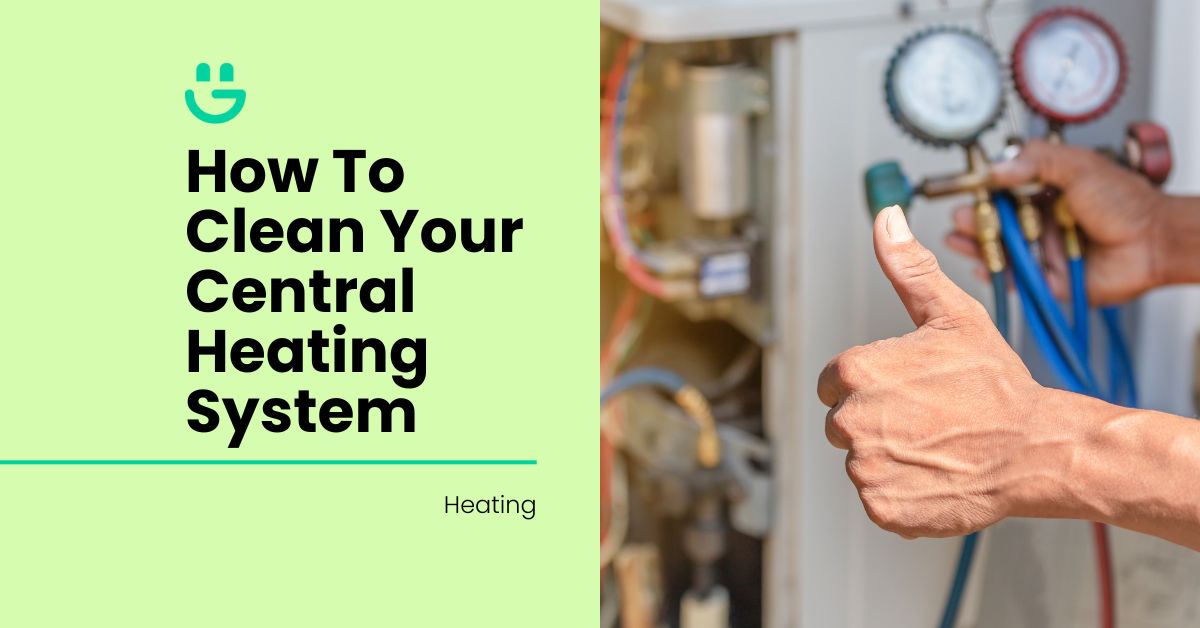Last Updated on November 14, 2025
Maintaining a clean central heating system is critical for maximising its performance and durability. Over time, your system can collect dirt, debris, and sludge, which can lead to problems like uneven heating, decreased heat production, and higher energy usage.
With regular cleaning and maintenance, you can avoid these common issues and reap its advantages—like reduced energy costs, better indoor air quality, and a cosier living space.
This detailed guide by Eco Happy will lead you through the step-by-step process of cleaning your central heating system. We’ll provide all the information you need to guarantee the peak performance and lifespan of your system.
Contents
Signs Your System Needs Cleaning
Preventing problems with your central heating system requires routine maintenance. Knowing when to clean your system can help you take care of major issues early on and save you money on replacements or expensive repairs.
Here are five common indicators that it’s time to clean your central heating system:
- Cold spots in your home: Cold areas in your house may indicate a clog or accumulation of dirt in your central heating system. This might be due to sludge or debris building in the pipes, which prevents effective heat distribution.
- Slow heating: If your home takes longer than usual to achieve your desired temperature, it may indicate that your central heating system needs cleaning. Over time, debris and silt can build up in the system, impeding the flow of hot water and reducing its effectiveness.
- Unusual noises: If your central heating system makes strange noises like pounding, gurgling, or whistling, do not disregard them. These sounds signal difficulties, such as trapped air pockets or mineral deposits in the system.
- Increase in energy bills: An unexplained rise in your energy expenses may indicate that your central heating system is not working effectively. This could be due to blocked filters or unclean components that make the system work harder, resulting in more energy.
Identifying these symptoms early on is essential. If ignored, they may worsen, resulting in safety risks or a complete system failure.
Advantages of regular system cleaning
You may wonder, “How will cleaning my system benefit me?”. Here are a few advantages to regular system cleaning:
- Improved energy efficiency and reduced bills: You can eliminate any accumulation or blockages that might impede the operation of your central heating system by giving it a routine cleaning. By doing this, you can improve the system’s efficiency and cut down on its energy use.
- Extended lifespan: You can reduce wear and tear and lower the risk of severe malfunctions and expensive repairs by keeping all the parts of your system clean and in good working order.
- Enhanced indoor air quality: Your heating system may collect dust, grime, and other impurities over time. These particles may spread throughout your house when the system operates, lowering the air quality. Routine cleaning can eliminate these contaminants, so you and your family can live in a healthier home.
- Reduced risk of safety hazards: A poorly maintained heating system can lead to carbon monoxide leaks and electrical problems. Frequent cleaning enables early identification of possible issues and timely replacements or repairs.
- Enhanced heating system performance: Regular cleaning of your heating system might also help it run more efficiently. When dust and dirt collect in the system, it reduces its efficiency and efficacy in heating your house. Keeping the system clean guarantees peak performance. It also provides continuous warmth and comfort throughout your living area.
Methods of Cleaning Central Heating Systems
Although cleaning your central heating system may seem overwhelming, we’ll help guide you through it! You can clean up dirt and debris buildup in a few easy steps to ensure optimal system performance. Here are the top methods for cleaning heating systems:
Power flush
A power flush is an efficient way to clean central heating systems. It involves pushing high-pressure water through the system with a solid pump to remove accumulated sludge, debris, and dirt. This procedure helps increase the heating system’s overall performance and efficiency. It also extends its lifespan.
When doing a power flush, consider the risk of displacing debris and creating obstructions in the system. Using the right tools and methods is crucial to reducing this threat. Furthermore, not all heating systems can benefit from this type of flushing, so speaking with an expert is essential.
Power flushing is usually required when your heating system shows low heat production, uneven heating, or strange noises. It’s also advisable to do so before installing a new boiler or radiator to ensure peak efficiency and avoid future complications.
Chemical flush
Chemical flushing involves adding a chemical cleanser to the system, which helps break down any sludge or debris accumulated over time. The chemical cleanser is kept in the system for a while so that it can eliminate any obstructions or buildup. After the chemical flush, the system is thoroughly cleaned with clean water to eliminate any leftover residue.
Specific chemical cleansers may include vital components that might be dangerous if not used correctly. When using chemical cleansers, it’s critical to stick to the manufacturer’s recommendations.
In older heating systems or those with significant buildup, you may need to do a couple of flushes to remove all debris and restore efficiency.
Chemical flushing is usually recommended when a heating system has low heat output, cold patches, or poor efficiency. It can also be done as a preventative strategy to ensure the system’s functionality and longevity.
Chemical flushing can be helpful after a system has been fixed or updated. It guarantees that any impurities or debris introduced during the process are eliminated.
Power flush vs chemical flush
During power flushing, any buildup or debris in the system is removed and flushed away using a high-pressure water jet. This technique can rapidly restore the ideal heat output of your system and help clear out complex obstructions.
Chemical flushing, on the other hand, involves using specific cleaning chemicals. These are pumped through the system to dissolve and eliminate any pollutants. This technique is frequently applied when power flushing is insufficient. It’s also used when there are particular problems, such as sludge buildup or corrosion.
While both methods aim to remove debris and improve performance, there are some key differences between the two. Let’s take a look at their pros and cons:
Power flushing pros
- Effective in removing stubborn blockages.
- Restores optimal heat output quickly.
- Can prolong the lifespan of the heating system.
- Helps improve energy efficiency.
- Removes sludge and debris, preventing further damage.
Power flushing cons
- It can be expensive, especially for larger systems.
- The system may need to be shut down during the process.
- Potential risk of leaks or damage to pipes if not done correctly.
- Some older systems may not be suitable for power flushing.
- It may cause temporary disruption to the water supply.
Chemical flushing pros
- Dissolves and removes contaminants effectively.
- Can target specific issues like corrosion or sludge buildup.
- Can extend the lifespan of the heating system.
- Improve energy efficiency by removing blockages.
- Less invasive compared to power flushing.
Chemical flushing cons
- Chemicals cause harm to you and your system if not handled properly.
- Requires careful monitoring of chemical concentration and exposure time.
- May take longer to see results compared to power flushing.
- Not practical for all types of blockages or issues in the heating system.
- May require multiple rounds of chemical flushing for desired results.
DIY vs Professional Cleaning
When cleaning your heating system, you may wonder whether to do it yourself or contact a professional. While DIY cleaning might be a low-cost solution, it requires a thorough grasp of the system and the essential tools. It might also cause further harm or violate warranties if not done correctly.
On the other hand, employing a professional assures that the task is completed efficiently. They have the expertise, skills, and specialised gear to clean your heating system. This lowers the possibility of errors or issues. Let’s get a closer look!
DIY pros and cons
Pros:
- DIY cleaning can save you money as you won’t have to pay for professional services.
- DIY cleaning gives you knowledge about your heating system and its maintenance.
- You have complete control over the cleaning process and can customise it according to your needs.
Cons:
- DIY cleaning requires a good understanding of the system.
- DIY cleaning can further damage your heating system or other components if not done correctly.
- Improper cleaning might void any warranties on your heating system.
- Cleaning a heating system yourself can be time-consuming, especially if you’re unfamiliar with the process.
- Professionals have access to specialised tools necessary for effective and thorough cleaning.
When to call for backup
It’s best to leave this job to the specialists if you’re unsure of any aspect of the cleaning process. Their expertise and experience enable them to perform the work effectively and securely. Hiring experts can also protect your heating system’s warranties and shelter you from future financial loss.
Additionally, they can access specialist equipment required for a comprehensive and efficient cleaning.
By relying on professionals, you can save yourself the time and effort of attempting a DIY cleaning that may not be as effective.
Step-By-Step Guides
While cleaning your central heating system may appear complex, it’s actually quite easy when you have the correct instructions and equipment for the job.
Let’s take a closer look at the following step-by-step guides:
How to power flush your central heating system
Here’s how to clean the central heating system using the power flush method:
Step 1: Preparation
Before you begin a power flush, cut off the power supply to your central heating system and close every drain or bleed valve and isolating switch. This will guarantee a thorough and secure cleaning procedure.
Next, collect all the required tools and supplies, including:
- Power flush machine
- Pump
- Power flush cleaner
- Inlet hose
- Bucket
Step 2: Using the power flush machine
Attach the power flush machine to your central heating system. Find the system’s bleed valve and fasten the hose’s end to it. The power flushing machine should be attached to the opposite end of the hose. Ensure every connection is secure to prevent leaks.
Reverse the water flow through your central heating system. This helps to remove any debris or sludge that may have built up over time.
Continuously check that the pressure and temperature levels stay within acceptable bounds throughout the power flush.
Tip: You can add a cleaning solution to the power flush machine to improve the cleaning process.
Step 3: Completion
Power flush each radiator separately when finished to ensure clean water is passing through them. Open the bleed valve at the bottom of each radiator until the water running out of each is clean. Doing this can clear up any leftover sludge or debris inside the system that may have dislodged.
Shut off all the radiator valves before you reconnect your central heating system.
After that, reopen the mains water supply valve to let clean water into the system. Listen for unusual noises or leaks when the water fills the radiators.
After the system reaches its ideal pressure, open the air vent and radiator valves to release any trapped air in the radiators. By doing this, all the radiators will heat up effectively and uniformly.
How to chemical flush your central heating system
Here’s how to clean the central heating system using the chemical flush method:
Step 1: Preparation
Ensure the power of your central heating system is off before starting the chemical flush. This is essential to protect the system from harm and ensure your safety.
Next, empty the system by following these steps:
- Locate the drain or bleed valve on your central heating system and attach a hose. Place the other end of the hose in a suitable container.
- Open all the bleed valves on your radiators to release any trapped air in the system.
- Close all the radiator valves tightly.
Step 2: Adding cleaner
Now that the system has been cleared and prepared for the flush, it’s time to add a cleanser. You can add the chemical cleanser to your central heating system in various ways, but safety should always come first.
One way is to pour the cleaner into the filling loop. Follow the manufacturer’s instructions and wear protective gloves.
Alternatively, use a dosing pot or specialised cleaning gadget to apply the cleaner in a regulated and safe manner. Whatever technique you pick, handle the chemicals carefully and dispose of any packaging responsibly.
The cleaning procedure may take a different amount of time, depending on the cleaner used and the state of your central heating system. Consider elements like your system’s size, the degree of blockages, and any particular guidelines the manufacturer may have given.
Step 3: System refilling
After cleaning, the next step is to refill the central heating system. This involves letting fresh water into the system and an appropriate inhibitor to prevent corrosion and scale buildup. Before refilling, ensure all drain and bleed valves are properly closed to avoid leakage.
After the system has been refilled, check for any leaks or evidence of water damage. Use your heating system to confirm that it is operational and that there are no circulation or airlock concerns.
Additional tips for system maintenance
- Regularly bleed your radiators to release any trapped air.
- Periodically check the pressure gauge to ensure it is within the approved range.
- Ensure your boiler is serviced annually to ensure peak performance and help spot any problems before they become serious.
- Consider installing magnetic filters and inhibitors to avoid dirt collection. The magnets stop magnetic particles or sludge from circulating and causing obstructions or damage in the system.
- Consider using inhibitors – chemical additions that aid in preventing scale accumulation and corrosion in the system.
These upkeep procedures will help your central heating system last longer and keep your home cosy during the winter.
FAQs
Is it worth flushing my central heating system?
Yes, cleaning your central heating system is well worth it. It aids with the removal of accumulated sludge, dirt, and rust, which can reduce your system’s performance and cause damage. A cleansed system also improves heat dispersion and can lengthen the life of your heating equipment.
How often should a central heating system be flushed?
How often you flush your central heating system will depend on a couple of factors, including the age of the system, your mains’ water quality, and the system’s energy consumption.
As a general rule, it’s advised to clean your system every 5–6 years. But, if you notice poor performance or your radiators are not heating evenly, you may need to clean the system sooner. Consulting with a professional heating engineer can help you identify the optimal flushing plan for your needs.
Can I flush my central heating system myself or should I hire a professional?
Though it is feasible to flush a central heating system yourself, it’s suggested that you hire a professional for the job. Flushing a system generally requires technical expertise and specific equipment to guarantee it’s accurate and effective.
A skilled heating engineer will be able to identify and fix any potential concerns throughout the flushing process, ensuring that your central heating system runs smoothly and lasts as long as possible.
Final Thoughts
Properly maintaining and cleaning your central heating system is critical to its longevity and effectiveness. By following the easy steps in this article, you can keep your system in excellent condition, ensuring constant warmth and comfort throughout your home.
Remember to examine and clean the components, such as the boiler, radiators, and pipes, and make any required repairs or replacements as soon as possible.
Scheduling boiler maintenance at least once a year is strongly advised to address any possible concerns and optimise the functioning of your system.
Need help cleaning your central heating system? Contact us at Eco Happy to schedule an appointment with one of our experienced technicians.






Tom Allen
Solar Expert